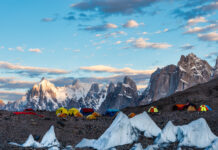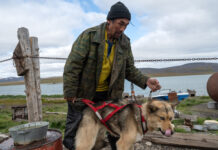Text and images by Subhasish Chakraborty
A team of Anthropologists from a Paris based NGO was scheduled to visit the Northeastern state of Nagaland. They were on the lookout for a French-speaking guide and made a request to a Kolkata travel management company with whom I was working. Since I knew the language as well as the geography of Nagaland, I was entrusted with the overall responsibility of the tour.
After the teams arrival at Calcutta and one full day of sightseeing in the City-of-Joy we departed for Dimapur by an Alliance Airlines flight from Kolkata. At Dimapur Airport, we were received by representatives of the Touphema Tourist Village, which was to be our base for our weeklong sojourn in Nagaland. From Dimapur, the Touphema Tourist Village is around 100 km, and the drive was beautiful.
At the village we were given a traditional Nagamese welcome. The Touphema Tourist Village is a destination in itself and showcases the very best of Nagaland’s tribal hospitality.
We had chosen this village so as to appreciate the tribal nuances of the people of Nagaland. In the villages of Nagaland, hutments are not merely meant to provide shelter. They signify social status, relevant adjustments to local climatic conditions, judicious use of locally available materials and the age-old cultural traditions all of which are interwoven in a fine blend.
The entire Tourist complex is well spread out in one of the highest elevation of the neighborhood, which in Nagaland’s tribal folklore are traditionally reserved for highly placed people of society. There was an exclusive reception center with a well-stocked pub and impeccably done up with traditional Nagamese architecture.
The clustered Naga huts are well spread out and the community lobby, kitchen, as well as the dining room signify the importance of space and are strategically located on the higher levels of the village. The community kitchen we were told is the central meeting place for guests of the village. It had comfortable seating arrangements and was spacious enough to store the foodstuff. We were absolutely awestruck with the intricately designed goblets and mugs which are undoubtedly organic yet very fashionable. We were offered the locally brewed liquor in those designer goblets.
As dusk descended upon the village, the ethereal sight of the red molten ball dipping on the distant mountainous horizon and the high octane cultural performance by the locals in their traditional attire, complete with bows and arrows made for a truly out of the world experience. My discerning French guests had never seen such a raw and animist tribal culture before.
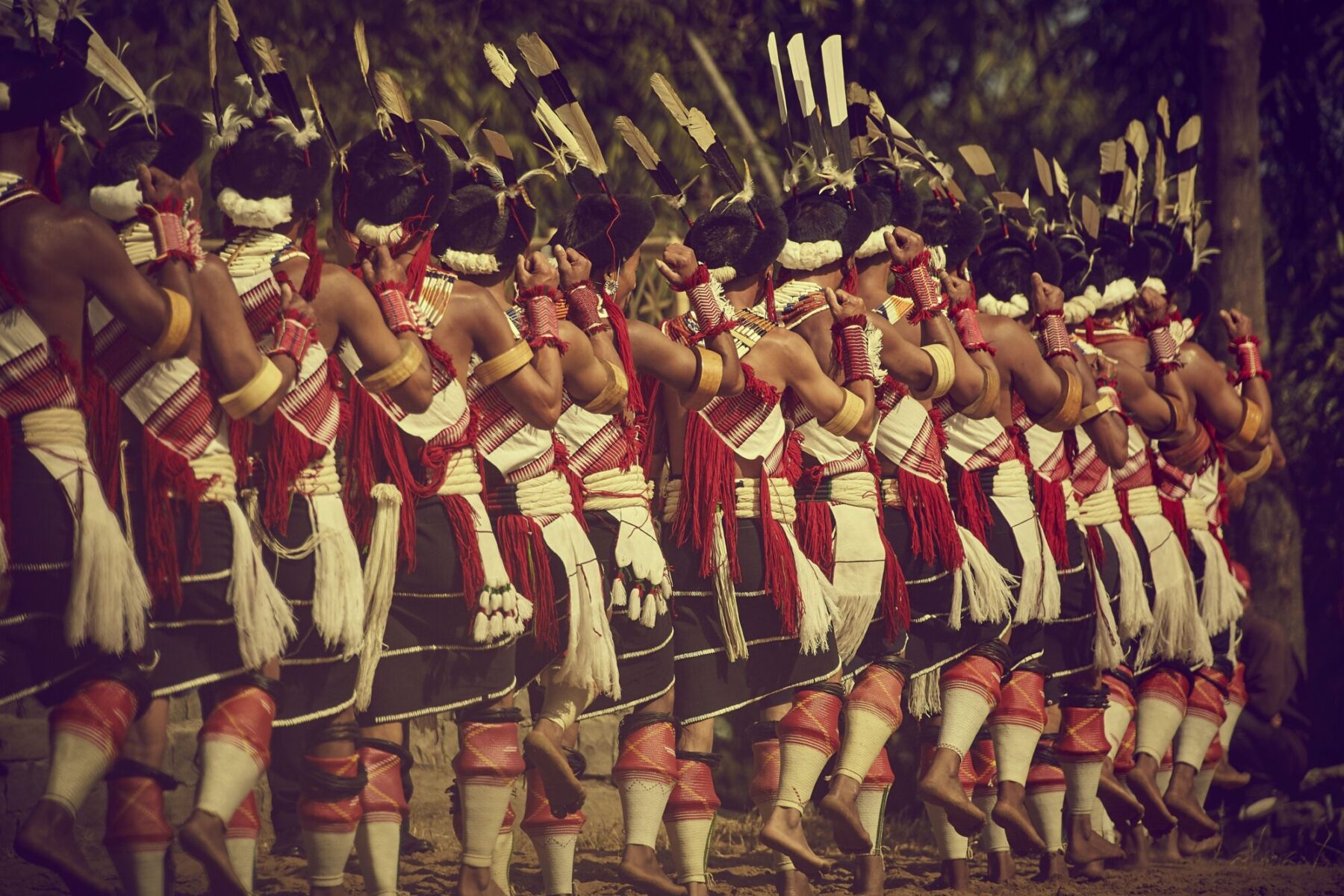

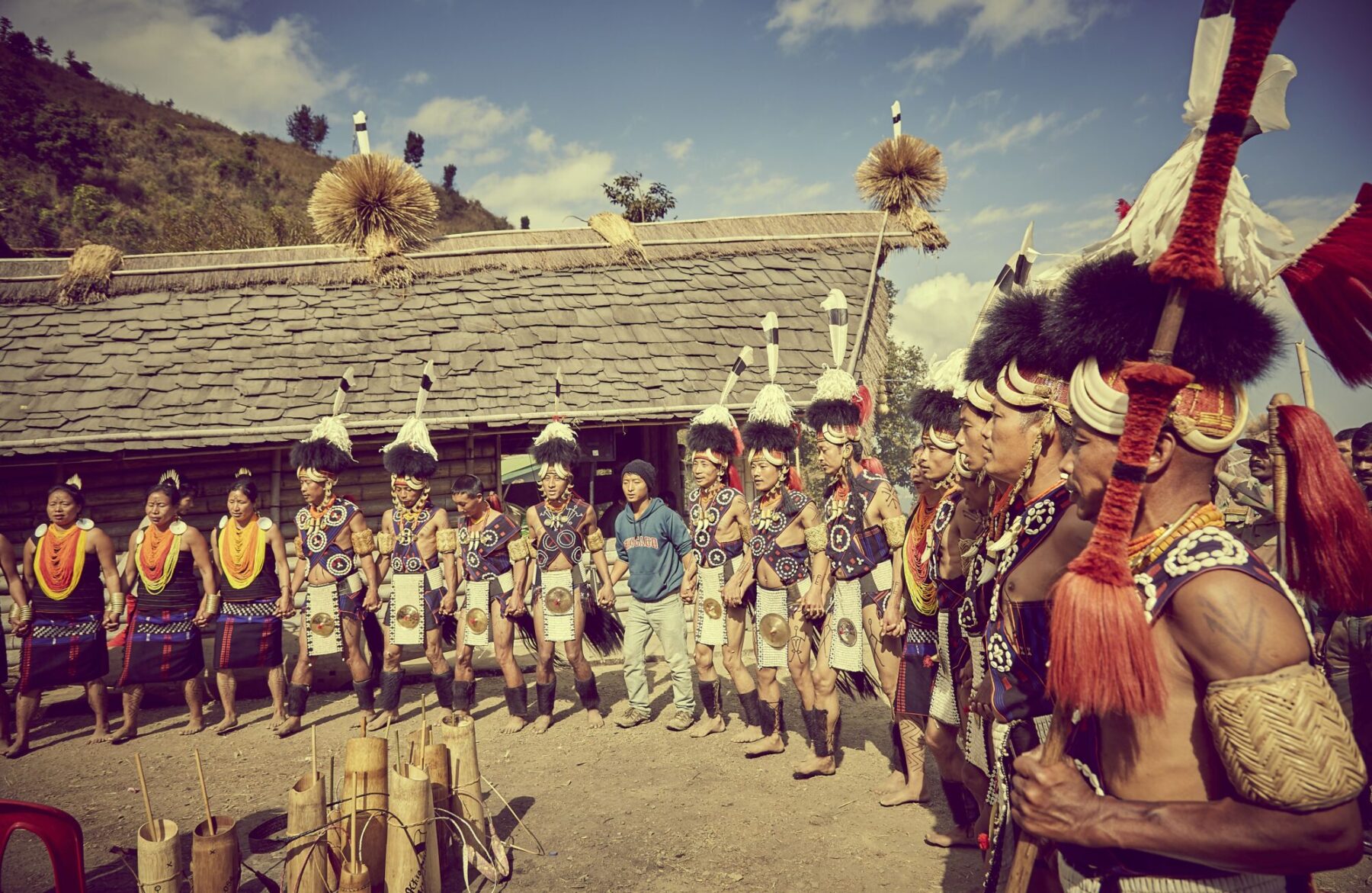
As darkness enveloped the village, the sight of the well spread out clustered huts was breathtaking. We were urged to go up close and explore the huts from a closer range. We found out to our utter amazement that each of the huts was theme based and the bedrooms that we were provided were luxurious with attached toilet and geyser. The solar battery powered lighting in this remote corner of India was something beyond our imagination.
The Touphema Tourist Village is one of the best places to explore the fascinating tribal culture of Nagaland and the innovative manner in which the Angami Naga culture has been portrayed in this dream Naga village is simply awesome.
Kohima, the state capital is located 74 km away from Dimapur. The name “Kohima” is derived from the Angami word “Kewhira” on whose land the township was established.
Kohima, we were told, was designated as the headquarters of the Naga Hills by the then Chief Commissioner of undivided Assam by Colonel Keating largely due to its strategic importance. This nondescript Naga town was the center of global attention during the World War II in the year 1944 when the mighty Japanese Army captured this Naga town for 64 days. Today, there is a War Memorial dedicated to those brave soldiers who laid down their lives in the infamous Battle of Kohima. A visit to the War Memorial is a must.
The climate of Kohima is salubrious and is located at an ideal altitude of 1444.12 meters above sea level. It is a year round destination and offers a nice getaway from the humdrum of city life. A few of my French guests were avid trekkers and couldn’t resist the temptation of embarking on a trek in the mountainous neighborhoods of Kohima while the rest of us went for something more sublime – visiting the colorful bazaars that were buzzing with activity. The shops were choc-a-bloc with hi-tech imported goods ranging from cameras to the latest laptop. I got pretty interested in an intricately designed Naga Shawl and seeing my enthusiasm, the rest of the group followed suit.
We were very impressed by Kohima’s cosmopolitan air. A typical Kohima marketplace is full of diverse Naga tribes some of whom come even from outside the state to do trading in the bustling bazaars of Kohima. We found Kohima to be an amalgam of diverse Naga tribes like Ao, Angami, and Rengma living in complete harmony with the modern world. The way they have adapted to the new age lifestyle is truly commendable. From high speed Internet connectivity to mobile phones, Kohima is on the verge of a rapid economic growth, particularly at a time when there are rumors doing the rounds in the governmental circles about developing a corridor for trade and commerce with the rest of Southeast Asia.
One of Kohima’s most enduring landmarks is the magnificent Catholic Cathedral ideally located on the impressive looking Aradurah Hill. The façade of the church is conspicuous by its geometrical design and is easily the largest cathedral of North East India and also a key place of Christian congregation.
Our guide Khaplang took us through a meandering alleyway that extended all the way to the Kohima Local Ground where a traditional Naga-style Wrestling competition was being held. My friends from France were awestruck by the half naked bodies of the wrestlers with just a loincloth for cover. Armed as they were with their Cannons and Nikons, a frenzied clicking of the cameras followed, which would be great take-away-home memories.
As a tourist destination, the biggest advantage that Nagaland enjoys is that Tourism is still not commercialized. In spite of the onslaught of modernity, Nagaland seems to be in a time wrap and insulated as it were from rapid advancement of science and technology. The sanity of the place is still intact which augurs well for the future.
Already there are telltale signs of progress visible in terms of tourism and we saw hordes of tourists from affluent Western countries as well as from mainland India chatting up with the locals over a sip or two of the locally brewed wine in the trendy marketplaces of Kohima.
Since we had come with the sole purpose of exploring the anthropological traits of the exotic Naga tribes, the Department of Tourism prepared an itinerary that would cover Mokokchung – Wokha – Zunheboto tourist circuit with a days halt at each of these places where tribal wizardry is still at work.
What amazed us at these remote villages was the innovative manner in which the Government of Nagaland had conceived a novel method of promoting Eco-Tourism whereby the local tribes generate their own income through community holding of tourism assets. At each of these villages we found an exclusive Village Tourism Board that was run and administered by the villagers themselves. In order to provide seamless and efficient services to the discerning world traveler, the government routinely conducts workshops and seminars where the villagers participate to upgrade their skill sets.
Mokokchung is the domain of the Ao Nagas and is conspicuous by its undulating hills that slope tenderly. My anthropologist friends from France began their mission to find out more about the fascinating lifestyle of the Ao Naga tribes and they were helped by a very knowledgeable guide that was provided to them by the Tourism Department.
We were told that the smallest social unit of the Ao Naga is the family. After marriage the bride and the groom leave their family of orientation and establish a new family. The Ao Nagas do not practice polygamy. As a family unit they live in complete harmony. If a younger member of the family quarrels with a senior person of the family, it is believed to be ominous not only to the family but also to the village as such.
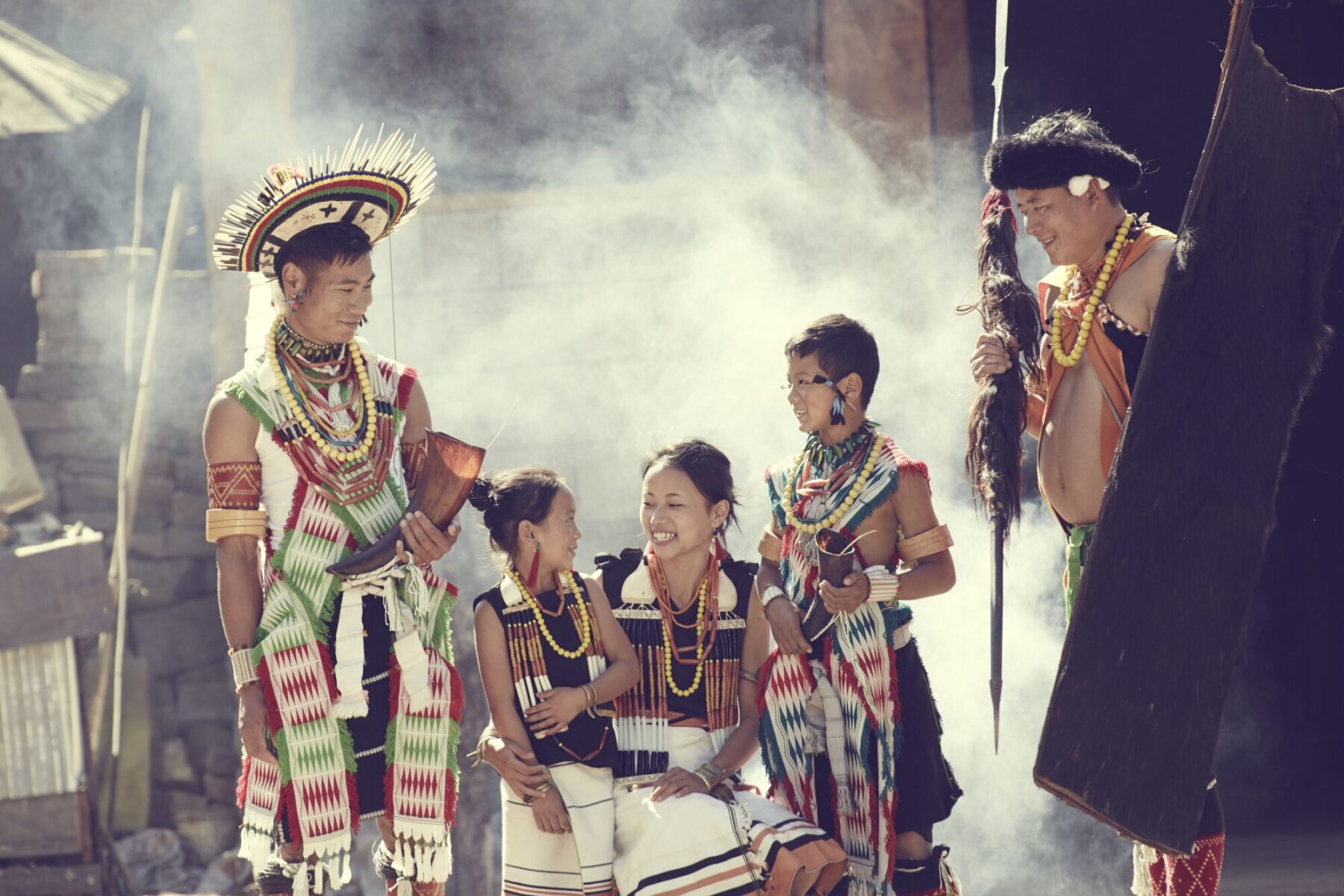
Ao Nagas also have clans and they are patriarchal and exogamous. The ‘Morung’ or Bachelor’s Dormitory plays a vital role in the social life of the Ao Naga village. Most ‘Morungs’ are fine work of craftsmanship. It serves both as a guardhouse as well as a clubhouse. The women are forbidden to enter inside a ‘Morung’. The young boys are admitted into the ‘Morung’ every three years to get trained practically in order to become a perfect man in all spheres.
There is no village chieftain as such and the village is run on democratic principles and each individual gets an opportunity to take part in the administration of the village.
Our trips to Wokha and Zunheboto were equally rewarding as we discovered many hidden secrets of the Naga tribes. We found out that every Naga tribe has a dialect of their own. The culture too varies with each tribe. The language is basically ‘Tibeto Burman’. We found the local tribals to be very hospitable. What’s more, the Naga tribes attach great importance to friendship.
The tribal people of Nagaland are traditionally adept in handloom and handicrafts products. Increasingly the indigenous Naga fashion designers are blending modern design patterns with the traditional style, thereby creating a completely new set of designer clothes and apparels. A visit to the Nagaland Emporium in Kohima can be a very rewarding experience for those obsessed with tribal fashion.
Visitors who are constrained for time would do well to visit Nagaland during the annual Hornbill Festival, which is a week long celebration showcasing the very best of Nagaland’s tribal culture and heritage. The Festival is held in the month of December at the charming village of Kisama. The theme of the festival is very apt – “Window to Nagaland”. Apart from the Hornbill Festival, there are year round festivals celebrated by the many tribes that reside in Nagaland. Check out with the Tourism Department for exact dates.
There is a sense of mysticism associated with Nagaland, which has been further heightened by its remoteness and geographical isolation. One can not only savor the ancient animist practices, but for instance, one were to embark on a jungle expedition, the lure of bonding with some of the most fascinating tribes on planet earth would invigorate even the most jaded traveler. Mother Earth has blessed this land with awesome natural grandeur and had Nobel laureate Rabindra Nath Tagore been alive today, he surely would have written a whole lot of poems highlighting the element of exoticism prevalent in this part of the world.
The Naga tribes are a breed apart. It is one of the best places to clinically observe how these fascinating tribals depend on supernatural beliefs. How they react to thunder, earthquake, drought, floods, life and death. The sheer joy of observing how the Naga tribes socialize in traditional age old kinship groups like family, lineage, the clan as also their reactions to modern institutions like club, society, school, college, governance etc…
The ethereal joy that a visitor experiences as he/she steps inside a quintessential Naga village and the tribal code of honor that he/she is bound by as a result of the visitor’s intrusion into the village and the consequent tribal hospitality that is extended to him/her is something which the jet set modern traveler is unaccustomed to. It is this element of unacquainted tribal generosity that awaits you here in Nagaland.
Traveler’s Fact File:
Getting There:
The only airport in the state of Nagaland is located at Dimapur. There are regular flights to Dimapur from Guwahati and Kolkota, which in turn are well connected by flights from other parts of India and abroad. From Dimapur, the capital of Nagaland – Kohima is 74 km away.
Dimapur also has a railway station and is well served by a number of trains from Guwahati, the gateway city of North East India.
By road, both Dimapur and Kohima, two of Nagaland’s most popular towns are well connected by buses from Guwahati.
One of the most convenient ways of reaching to Kohima from Guwahati is either by traveling on train or air to Dimapur and from Dimapur by road to Kohima. Taxis and cabs can be easily hired at both Dimapur Railway Station and Airport.
For the up market tourist, there is always the option of driving non-stop from Guwahati to Kohima. The distance can be covered in about 5-6 hours and the drive is beautiful as one passes by quaint tribal villages, stretches of tropical forest, undulating hills and good wayside amenities.
Accommodation:
As far as quality accommodation in Kohima is concerned, the best option is the super luxurious – The Ultimate Travelling Camp (TUTC).TUTC are pioneers in “Luxury Camping” in some of India’s most remote locales.
For reservations, please feel free to get in touch with –
Kohima Camp, Nagaland Address & Contact Info :
Tekweuju, Above Japfu Christian college,
Kigwema, Pin 797001, Kohima, Nagaland. India : Call + 91 801 090 2222 Email info@tutc.com
UK / Europe : Call +44 207 808 5691, Email maggi.nixon@tutc.com
US : Call +1 212 967 5895, Email jgblackbook@tutc.com
UAE : Call +971 561 302 570, Email gcc@tutc.com
_________________________________________________________________________
About Subhasish Chakraborty
 Subhasish Chakraborty has been working as a travel journalist for the past two decades and has been editorially involved with numerous international in-flight magazines of renowned airlines like Cathay Pacific, Dragon Air, Bhutan Airlines, Air Asia, Airport Authority of India and many more. He was also involved with the UNWTO (World Tourism Organization) as a consultant.
Subhasish Chakraborty has been working as a travel journalist for the past two decades and has been editorially involved with numerous international in-flight magazines of renowned airlines like Cathay Pacific, Dragon Air, Bhutan Airlines, Air Asia, Airport Authority of India and many more. He was also involved with the UNWTO (World Tourism Organization) as a consultant.
For more captivating stories like this one, subscribe to Asian Geographic Magazine here.


![tribes-morungs-04_highres[1]](https://asiangeo.com/wp-content/uploads/2022/07/tribes-morungs-04_highres1-696x464.jpg)


